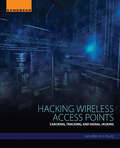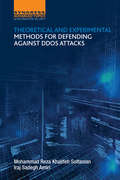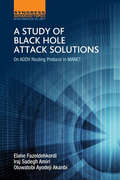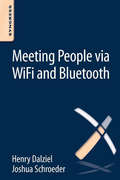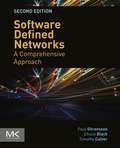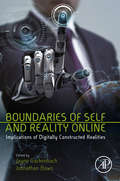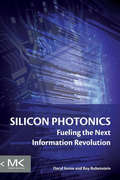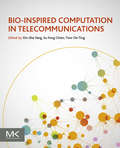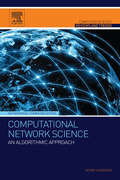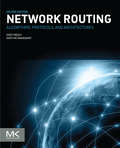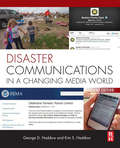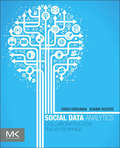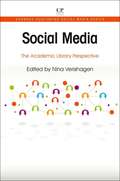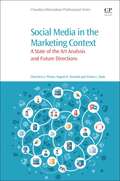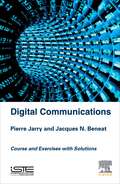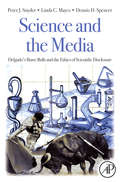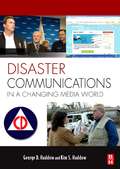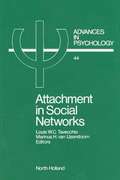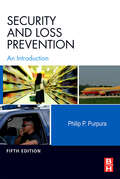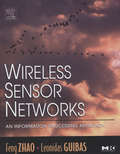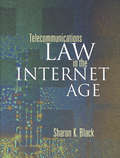- Table View
- List View
Hacking Wireless Access Points: Cracking, Tracking, and Signal Jacking
by Jennifer KurtzHacking Wireless Access Points: Cracking, Tracking, and Signal Jacking provides readers with a deeper understanding of the hacking threats that exist with mobile phones, laptops, routers, and navigation systems. In addition, applications for Bluetooth and near field communication (NFC) technology continue to multiply, with athletic shoes, heart rate monitors, fitness sensors, cameras, printers, headsets, fitness trackers, household appliances, and the number and types of wireless devices all continuing to increase dramatically. The book demonstrates a variety of ways that these vulnerabilities can be—and have been—exploited, and how the unfortunate consequences of such exploitations can be mitigated through the responsible use of technology. Explains how the wireless access points in common, everyday devices can expose us to hacks and threatsTeaches how wireless access points can be hacked, also providing the techniques necessary to protect and defend dataPresents concrete examples and real-world guidance on how to protect against wireless access point attacks
Theoretical and Experimental Methods for Defending Against DDoS Attacks
by Iraj Sadegh Amiri Mohammad Reza SoltanianDenial of Service (DoS) attacks are a form of attack that seeks to make a network resource unavailable due to overloading the resource or machine with an overwhelming number of packets, thereby crashing or severely slowing the performance of the resource. Distributed Denial of Service (DDoS) is a large scale DoS attack which is distributed in the Internet. Every computer which has access to the Internet can behave as an attacker. Typically bandwidth depletion can be categorized as either a flood or an amplification attack. Flood attacks can be done by generating ICMP packets or UDP packets in which it can utilize stationary or random variable ports. Smurf and Fraggle attacks are used for amplification attacks. DDoS Smurf attacks are an example of an amplification attack where the attacker sends packets to a network amplifier with the return address spoofed to the victim’s IP address. This book presents new research and methodologies along with a proposed algorithm for prevention of DoS attacks that has been written based on cryptographic concepts such as birthday attacks to estimate the rate of attacks generated and passed along the routers. Consequently, attackers would be identified and prohibited from sending spam traffic to the server which can cause DDoS attacks. Due to the prevalence of DoS attacks, there has been a lot of research conducted on how to detect them and prevent them. The authors of this short format title provide their research results on providing an effective solution to DoS attacks, including introduction of the new algorithm that can be implemented in order to deny DoS attacks.A comprehensive study on the basics of network securityProvides a wide revision on client puzzle theoryAn experimental model to mitigate distributed denial of service (DDoS) attacks
A Study of Black Hole Attack Solutions: On AODV Routing Protocol in MANET
by Elahe Fazeldehkordi Iraj Sadegh Amiri Oluwatobi Ayodeji AkanbiMobile Ad Hoc Networks (MANETs) are a popular form of network for data transfer due to the fact that they are dynamic, require no fixed infrastructure, and are scalable. However, MANETs are particularly susceptible to several different types of widely perpetrated cyberattack. One of the most common hacks aimed at MANETs is the Black Hole attack, in which a particular node within the network displays itself as having the shortest path for the node whose packets it wants to intercept. Once the packets are drawn to the Black Hole, they are then dropped instead of relayed, and the communication of the MANET is thereby disrupted, without knowledge of the other nodes in the network. Due to the sophistication of the Black Hole attack, there has been a lot of research conducted on how to detect it and prevent it. The authors of this short format title provide their research results on providing an effective solution to Black Hole attacks, including introduction of new MANET routing protocols that can be implemented in order to improve detection accuracy and network parameters such as total dropped packets, end-to-end delay, packet delivery ratio, and routing request overhead. Elaborates on the basics of wireless networks, MANETsExplains the significance behind the need of wireless networks and MANET securityUnderstand MANET routing protocols, namely the ADOV method
Meeting People via WiFi and Bluetooth
by Henry Dalziel Joshua SchroederMeeting People via WiFi and Bluetooth will contain an overview of how to track people using Wireless 802.11 Radio Frequencies (Wi-Fi) and Bluetooth 802.15 Radio Frequencies. The content contained here came from research and materials originally presented at Defcon Wireless CTF Village in August 2015 entitled "Meeting People Via Wi-Fi". The book will go over the hardware and software needed in order to do this tracking, how to use these particular tools in order to do attribution, and tips for protecting yourself from being attributed via those signals.Offers an overview of how to track people using WiFi and Bluetooth technologies
Software Defined Networks: A Comprehensive Approach
by Chuck Black Paul Goransson Timothy CulverSoftware Defined Networks: A Comprehensive Approach, Second Edition provides in-depth coverage of the technologies collectively known as Software Defined Networking (SDN). The book shows how to explain to business decision-makers the benefits and risks in shifting parts of a network to the SDN model, when to integrate SDN technologies in a network, and how to develop or acquire SDN applications. In addition, the book emphasizes the parts of the technology that encourage opening up the network, providing treatment for alternative approaches to SDN that expand the definition of SDN as networking vendors adopt traits of SDN to their existing solutions. Since the first edition was published, the SDN market has matured, and is being gradually integrated and morphed into something more compatible with mainstream networking vendors. This book reflects these changes, with coverage of the OpenDaylight controller and its support for multiple southbound protocols, the Inclusion of NETCONF in discussions on controllers and devices, expanded coverage of NFV, and updated coverage of the latest approved version (1.5.1) of the OpenFlow specification.Contains expanded coverage of controllersIncludes a new chapter on NETCONF and SDNPresents expanded coverage of SDN in optical networksProvides support materials for use in computer networking courses
Boundaries of Self and Reality Online: Implications of Digitally Constructed Realities
by Jayne Gackenbach Johnathan BownAs technology continues to rapidly advance, individuals and society are profoundly changed. So too are the tools used to measure this universe and, therefore, our understanding of reality improves. Boundaries of Self and Reality Online examines the idea that technological advances associated with the Internet are moving us in multiple domains toward various "edges." These edges range from self, to society, to relationships, and even to the very nature of reality. Boundaries are dissolving and we are redefining the elements of identity. The book begins with explorations of the digitally constructed self and the relationship between the individual and technological reality. Then, the focus shifts to society at large and includes a contribution from Chinese researchers about the isolated Chinese Internet. The later chapters of the book explore digital reality at large, including discussions on virtual reality, Web consciousness, and digital physics.Cyberpsychology architectureVideo games as a tool for self-understandingAvatars and the meaning behind themGame transfer phenomenaA Jungian perspective on technologyPolitics of social mediaThe history and science of video game playTranscendent virtual reality experiencesThe theophoric quality of video games
Silicon Photonics: Fueling the Next Information Revolution
by Daryl Inniss Roy RubensteinSilicon photonics uses chip-making techniques to fabricate photonic circuits. The emerging technology is coming to market at a time of momentous change. The need of the Internet content providers to keep scaling their data centers is becoming increasing challenging, the chip industry is facing a future without Moore’s law, while telcos must contend with a looming capacity crunch due to continual traffic growth. Each of these developments is significant in its own right. Collectively, they require new thinking in the design of chips, optical components, and systems. Such change also signals new business opportunities and disruption. Notwithstanding challenges, silicon photonics’ emergence is timely because it is the future of several industries. For the optical industry, the technology will allow designs to be tackled in new ways. For the chip industry, silicon photonics will become the way of scaling post-Moore’s law. New system architectures enabled by silicon photonics will improve large-scale computing and optical communications. Silicon Photonics: Fueling the Next Information Revolution outlines the history and status of silicon photonics. The book discusses the trends driving the datacom and telecom industries, the main but not the only markets for silicon photonics. In particular, developments in optical transport and the data center are discussed as are the challenges. The book details the many roles silicon photonics will play, from wide area networks down to the chip level. Silicon photonics is set to change the optical components and chip industries; this book explains how.Captures the latest research assessing silicon photonics development and prospectsDemonstrates how silicon photonics addresses the challenges of managing bandwidth over distance and within systemsExplores potential applications of SiP, including servers, datacenters, and Internet of Things
Bio-Inspired Computation in Telecommunications
by Xin-She Yang Su Fong Chien T.O. TingBio-inspired computation, especially those based on swarm intelligence, has become increasingly popular in the last decade. Bio-Inspired Computation in Telecommunications reviews the latest developments in bio-inspired computation from both theory and application as they relate to telecommunications and image processing, providing a complete resource that analyzes and discusses the latest and future trends in research directions. Written by recognized experts, this is a must-have guide for researchers, telecommunication engineers, computer scientists and PhD students.
Computational Network Science: An Algorithmic Approach (Computer Science Reviews and Trends)
by Henry HexmoorThe emerging field of network science represents a new style of research that can unify such traditionally-diverse fields as sociology, economics, physics, biology, and computer science. It is a powerful tool in analyzing both natural and man-made systems, using the relationships between players within these networks and between the networks themselves to gain insight into the nature of each field. Until now, studies in network science have been focused on particular relationships that require varied and sometimes-incompatible datasets, which has kept it from being a truly universal discipline. Computational Network Science seeks to unify the methods used to analyze these diverse fields. This book provides an introduction to the field of Network Science and provides the groundwork for a computational, algorithm-based approach to network and system analysis in a new and important way. This new approach would remove the need for tedious human-based analysis of different datasets and help researchers spend more time on the qualitative aspects of network science research.Demystifies media hype regarding Network Science and serves as a fast-paced introduction to state-of-the-art concepts and systems related to network scienceComprehensive coverage of Network Science algorithms, methodologies, and common problemsIncludes references to formative and updated developments in the fieldCoverage spans mathematical sociology, economics, political science, and biological networks
Network Routing: Algorithms, Protocols, and Architectures (ISSN)
by Deep Medhi Karthik RamasamyNetwork Routing: Algorithms, Protocols, and Architectures, Second Edition, explores network routing and how it can be broadly categorized into Internet routing, circuit-switched routing, and telecommunication transport network routing. The book systematically considers these routing paradigms, as well as their interoperability, discussing how algorithms, protocols, analysis, and operational deployment impact these approaches and addressing both macro-state and micro-state in routing. Readers will learn about the evolution of network routing, the role of IP and E.164 addressing and traffic engineering in routing, the impact on router and switching architectures and their design, deployment of network routing protocols, and lessons learned from implementation and operational experience. Numerous real-world examples bring the material alive.Extensive coverage of routing in the Internet, from protocols (such as OSPF, BGP), to traffic engineering, to security issues A detailed coverage of various router and switch architectures, IP lookup and packet classification methodsA comprehensive treatment of circuit-switched routing and optical network routingNew topics such as software-defined networks, data center networks, multicast routingBridges the gap between theory and practice in routing, including the fine points of implementation and operational experienceAccessible to a wide audience due to its vendor-neutral approach
Disaster Communications in a Changing Media World
by Kim Haddow George D. HaddowCommunications are key to the success of disaster mitigation, preparedness, response, and recovery. Accurate information disseminated to the general public, to elected officials and community leaders, as well as to the media, reduces risk, saves lives and property, and speeds recovery. Disaster Communications in a Changing Media World, Second Edition, provides valuable information for navigating these priorities in the age of evolving media. The emergence of new media like the Internet, email, blogs, text messaging, cell phone photos, and the increasing influence of first informers are redefining the roles of government and media. The tools and rules of communications are evolving, and disaster communications must also evolve to accommodate these changes and exploit the opportunities they provide. Disaster Communications in a Changing Media World, Second Edition, illuminates the path to effective disaster communication, including the need for transparency, increased accessibility, trustworthiness and reliability, and partnerships with the media.Includes case studies from recent disasters including Hurricane Sandy, the 2011 tsunami in Japan, and the Boston Marathon bombingsDemonstrates how to use blogs, text messages, and cell phone cameras, as well as government channels and traditional media, to communicate during a crisisExamines current social media programs conducted by FEMA, the American Red Cross, state and local emergency managers, and the private sectorUpdated information in each chapter, especially on how social media has emerged as a force in disaster communications
Social Data Analytics: Collaboration for the Enterprise (The Morgan Kaufmann Series on Business Intelligence)
by Krish Krishnan Shawn P. RogersSocial Data Analytics is the first practical guide for professionals who want to employ social data for analytics and business intelligence (BI). This book provides a comprehensive overview of the technologies and platforms and shows you how to access and analyze the data. You'll explore the five major types of social data and learn from cases and platform examples to help you make the most of sentiment, behavioral, social graph, location, and rich media data. A four-step approach to the social BI process will help you access, evaluate, collaborate, and share social data with ease. You'll learn everything you need to know to monitor social media and get an overview of the leading vendors in a crowded space of BI applications. By the end of this book, you will be well prepared for your organization’s next social data analytics project.Provides foundational understanding of new and emerging technologies—social data, collaboration, big data, advanced analyticsIncludes case studies and practical examples of success and failuresWill prepare you to lead projects and advance initiatives that will benefit you and your organization
Social Media: The Academic Library Perspective (Chandos Publishing Social Media Ser. (PDF))
by Nina VerishagenSocial Media: The Academic Library Perspective provides a step-by-step guide on social media as written by somebody who has already done the work. Made up of case studies written by authors at various institutions who provide different perspectives on their institution’s use of social media, the book highlights successes and failures, while also focusing on tips for social media management in the academic library that anybody in the community can interpret and adapt. Social media platforms are dealt with systematically, making this an essential guide for librarians who want to use social media to the benefit of their library. Includes a step-by-step guide on the use of social media for academic libraries Presents practical experience leveraged in the form of case studies Provides quick, concise, and systematic recommendations for the use of social media Written by academic librarians for academic librarians
SOCIAL MEDIA IN THE MARKETING CONTEXT: A State of the Art Analysis and Future Directions (pdf)
by Geoff Walton Woody Evans Cherniece J. Plume Yogesh K. Dwivedi Emma L. Slade9780081017548
Digital Communications: Courses and Exercises with Solutions
by Pierre Jarry Jacques N. BeneatDigital communications plays an important role in numerical transmission systems due to the proliferation of radio beams, satellite, optic fibbers, radar, and mobile wireless systems. This book provides the fundamentals and basic design techniques of digital communications with an emphasis on the systems of telecommunication and the principles of baseband transmission. With a focus on examples and exercises, this book will prepare you with a practical and real-life treatment of communication problems.A complete analysis of the structures used for emission or reception technologyA set of approaches for implementation in current and future circuit designA summary of the design steps with examples and exercises for each circuit
Concise Encyclopedia of Brain and Language (Concise Encyclopedias of Language and Linguistics)
by Harry A. WhitakerThis volume descibes, in up-to-date terminology and authoritative interpretation, the field of neurolinguistics, the science concerned with the neural mechanisms underlying the comprehension, production and abstract knowledge of spoken, signed or written language. An edited anthology of 165 articles from the award-winning Encyclopedia of Language and Linguistics 2nd edition, Encyclopedia of Neuroscience 4th Edition and Encyclopedia of the Neorological Sciences and Neurological Disorders, it provides the most comprehensive one-volume reference solution for scientists working with language and the brain ever published. Authoritative review of this dynamic field placed in an interdisciplinary contextApproximately 165 articles by leaders in the fieldCompact and affordable single-volume format
Technical, Commercial and Regulatory Challenges of QoS: An Internet Service Model Perspective (ISSN)
by XiPeng XiaoTechnical, Commerical and Regulatory Challenges of QoS provides a comprehensive examination of Internet QoS theory, standards, vendor implementation and network deployment from the practitioner's point of view, including extensive discussion of related economic and regulatory issues. Written in a technology-light way so that a variety of professionals and researchers in the information and networking industries can easily grasp the material. Includes case studies based on real-world experiences from industry. The author starts by discussing the economic, regulatory and technical challenges of the existing QoS model. Key coverage includes defining a clear business model for selling and buying QoS in relation to current and future direction of government regulation and QoS interoperability (or lack thereof) between carriers and networking devices. The author then demonstrates how to improve the current QoS model to create a clear selling point, less regulation uncertainty, and higher chance of deployment success. This includes discussion of QoS re-packaging to end-users; economic and regulatory benefits of the re-packaging; and the overall benefits of an improved technical approach. Finally, the author discusses the future evolution of QoS from an Internet philosophy perspective and lets the reader draw the conclusions. This book is the first QoS book to provide in depth coverage on the commercial and regulatory aspects of QoS, in addition to the technical aspect. From that, readers can grasp the commercial and regulatory issues of QoS and their implications on the overall QoS business model. This book is also the first QoS book to provide case studies of real world QoS deployments, contributed by the people who did the actual deployments. From that, readers can grasp the practical issues of QoS in real world. This book is also the first QoS book to cover both wireline QoS and wireless QoS. Readers can grasp the QoS issues in the wireless world. The book was reviewed and endorsed by a long list of prominent industrial and academic figures.Discusses QoS technology in relation to economic and regulatory issuesIncludes case studies based on real-world examples from industry practitionersProvides unique insight into how to improve the current QoS model to create a clear selling point, less regulatory uncertainty, and higher chance of deployment success
Science and the Media: Delgado's Brave Bulls and the Ethics of Scientific Disclosure
by Peter J. Snyder Linda C. Mayes Dennis SpencerOf great utility for every scientist faced with publicizing their discoveries via the media, this book addresses questions of responsibility for the balance and accuracy of scientific reporting, and attempts to be a guide for the scientist in their quest to inform the general public about their research in honest, truthful, and still interesting ways. Case studies by leading scholars in the fields of bioethics (pharmaceutical research (Declan Doogan, Senior VP Pfizer), medical journal editing (Jerome Kassirer, former editor of NEJM), science journalism, philosophy of science, history of medicine (John Warner, chair history of medicine Yale), public health (Ruth Katz, Dean public health, George Washington University), and philosophy of religion (Reverend Wesley Carr, former Dean of Westminster) illustrate positions and points of view and offer unique perspectives on the complex dance between science and the media.Provides a compelling overview and analysis of the difficulties of dealing with mass media and collects tips and solutions.Includes case studies from the experience of a number of high-profile contributors from different fieldsProvides an easy-to-read, carefully selected and synthesized overview well suited to teaching and as further reading source in respective classesIncludes a famous movie from Jose Delgado that shows his attempts in the 60s to demonstrate "remote control" of a bull
Maritime Security: An Introduction
by Michael McNicholasThe commercial maritime sector is highly vulnerable to theft and piracy, and presents a probable target for a major terrorist attack. The best way to prevent losses is to apply lessons learned in another arena-–the struggle to curb drug smuggling. This effort has shown that successes can be achieved when effective and comprehensive security measures and procedures are implemented at key initial links in the cargo supply chain. The integrity and security of whole system are improved when efforts are focused at the primary "choke point" – the load seaports and their ships. This book provides practical, experience-based, and proven knowledge - and a "how-to-guide" - on maritime security. McNicholas explains in clear language how commercial seaports and vessels function; what threats currently exist; what security policies, procedures, systems, and measures must be implemented to mitigate these threats; and how to conduct ship and port security assessments and plans. Whether the problem is weapons of mass destruction or cargo theft, Maritime Security provides invaluable guidance for the professionals who protect our shipping and ports.Holds the keys to successfully designing, implementing, and managing effective port and vessel security programs in a high-risk environmentProvides real-world experience in Maritime Security from the Managing Director of Phoenix Management Services Group in the USA and Panama.Offers specifics of a model port security program and case studies of effective tactics in a high-threat environment
Disaster Communications in a Changing Media World
by Kim Haddow George D. HaddowCommunications is key to the success of disaster mitigation, preparedness, response and recovery. Accurate information disseminated to the general public, to elected officials and community leaders, and to the media reduces risk, saves lives and property, and speeds recovery. The ability to communicate is no longer an afterthought or a luxury; timely communication is now as important as logistics or the pre-deployment of materials. Planning and controlling the flow of information before, during and after a disaster will define your organization's credibility, trustworthiness, authority, and effectiveness.The emergence of new media like the internet, e-mail, blogs, text messaging, cell phone photos, and the increasing role played by "first informers"-- witnesses who now have the ability to transmit information immediately from the event--are redefining the roles of government and media.The government's historical role as gatekeeper is now an anachronism. Traditional media's role as the sole conduit of reliable and officially-sanctioned information has been eclipsed by the advent of new media. The tools and rules of communications are evolving and disaster communications must evolve to capitalize on these changes and exploit the opportunities they provide. Bloggers have the potential either to add to the chaos during a crisis, or to help convey accurate data and report on local conditions. Disaster communications must incorporate a way to manage their impact and if possible use them for the common good.Finally, even though the means to the end are evolving, the goals, the values, and the underlying principles of effective disaster communication-- the need for transparency, increased accessibility, trustworthiness and reliability, and to create partnerships with the media--have not changed and need to be embraced along with the practical ability to convey information effectively. * Applies the principles of emergency management to communications during a disaster* Covers terrorist incidents, accidents, and natural disasters like hurricanes and earthquakes* Shows how to use blogs, text messages, and cell phone cameras as well as government channels and traditional media to communicate during a crisis
Attachment in Social Networks: Contributions to the Bowlby-Ainsworth Attachment Theory (ISSN #Volume 44)
by L W C Tavecchio M. H. Van IJzendoornThe main objective of the research presented in this book is to broaden the scope of attachment theory by stressing the importance of a social network approach to the study of attachment.This approach forms the integrating theme of this volume, as is testified by various studies of attachment as it develops in an "extended" rearing context over and beyond the limits of the traditional mother-child dyad. In this connection attention is paid to the importance of sibling relationships, attachment relationships with professional caregivers, the role of the father in caring and rearing young children, and the (short-term and long-term) effects on attachment quality of maternal employment in infancy. Also, the cross-cultural validity of Ainsworth's Strange Situation is discussed, with reference to the USA, Sweden, Israel, Japan, The Netherlands, etc. In adopting a social network approach, the attachment theory proves to be a particularly useful instrument for reflecting on the consequence of social change (maternal employment, symmetrical families, socialisation of childrearing) for child development.
Security and Loss Prevention: An Introduction
by Philip PurpuraSecurity and Loss Prevention, Fifth Edition, encompasses the breadth and depth of considerations involved in implementing general loss prevention concepts and security programs within an organization. It presents proven strategies to prevent and reduce incidents of loss due to legal issues, theft and other crimes, fire, accidental or intentional harm from employees as well as the many ramifications of corporate mismanagement. It contains a brand new terrorism chapter, along with coverage on background investigations, protection of sensitive information, internal threats, and considerations at select facilities (nuclear, DoD, government and federal). Author Philip Purpura once again demonstrates why students and professionals alike rely on this best-selling text as a timely, reliable resource. This book is an ideal resource for criminal justice and security academic programs, physical security professionals, retail security professionals, security managers, security consultants, law enforcement professionals, investigations professionals, risk and contingency planning professionals.- Covers the latest professional security issues surrounding Homeland Security and risks presented by threats of terrorism- Recommended reading for ASIS International's prestigious CPP Certification- Cases provide real-world applications
Elsevier's Dictionary of Acronyms, Initialisms, Abbreviations and Symbols
by Fioretta. Benedetto MattiaThe dictionary contains an alphabetical listing of approximately 30,000 (thirty thousand) acronyms, initialisms, abbreviations and symbols covering approximately 2,000 fields and subfields ranging from Pelagic Ecology to Anthrax Disease, Artificial Organs to Alternative Cancer Therapies, Age-related Disorders to Auditory Brainstem Implants, Educational Web Sites to Biodefense, Biomedical Gerontology to Brain Development, Cochlear Implants to Cellular Phones, Constructed Viruses to Copper Metabolism, Drug Discovery Programs to Drug-resistant Strains, Eugenics to Epigenetics, Epilepsy Drugs to Fertility Research, Genetically Modified Foods/Crops to Futuristic Cars, Genetic Therapies to Glycobiology, Herbicide-tolerant Crops to Heritable Disorders, Human Chronobiology to Human gene Therapies, Immunization Programs to Lunar Research, Liver Transplantation to Microchip Technology, Mitochondrial Aging to Molecular Gerontology, Neurodegenerative Diseases to Neuropsychology of Aging, Neurosurgery to Next Generation Programs, Obesity Research to Prion Diseases, Quantum Cryptography to Reemerging Diseases, Retinal Degeneration to Rice Genome Research, Social Anthropology to Software Development, Synchrotron Research to Vaccine Developments, Remote Ultrasound Diagnostics to Water Protection, Entomology to Chemical Terrorism and hundreds of others, as well as abbreviations/acronyms/initialisms relating to European Community and U.S., Japanese and International Programs/Projects/Initiatives from year 2000 up to 2010 as well as World Bank Programs.
Wireless Sensor Networks: An Information Processing Approach (ISSN)
by Feng Zhao Leonidas GuibasInformation processing in sensor networks is a rapidly emerging area of computer science and electrical engineering research. Because of advances in micro-sensors, wireless networking and embedded processing, ad hoc networks of sensor are becoming increasingly available for commercial, military, and homeland security applications. Examples include monitoring (e.g., traffic, habitat, security), industrail sensing and diagnostics (e.g., factory, appliances), infrastructures (i.e., power grid, water distribution, waste disposal) and battle awareness (e.g., multi-target tracking). This book introduces practitioners to the fundamental issues and technology constraints concerning various aspects of sensor networks such as information organization, querying, routing, and self-organization using concrete examples and does so by using concrete examples from current research and implementation efforts.Written for practitioners, researchers, and students and relevant to all application areas, including environmental monitoring, industrial sensing and diagnostics, automotive and transportation, security and surveillance, military and battlefield uses, and large-scale infrastructural maintenanceSkillfully integrates the many disciplines at work in wireless sensor network design: signal processing and estimation, communication theory and protocols, distributed algorithms and databases, probabilistic reasoning, energy-aware computing, design methodologies, evaluation metrics, and moreDemonstrates how querying, data routing, and network self-organization can support high-level information-processing tasks
Telecommunications Law in the Internet Age (ISSN)
by Sharon K. BlackFor companies in and around the telecommunications field, the past few years have been a time of extraordinary change-technologically and legally. The enacting of the Telecommunications Act of 1996 and the development of international trade agreements have fundamentally changed the environment in which your business operates, creating risks, responsibilities, and opportunities that were not there before.Until now, you'd have had a hard time finding a serious business book that offered any more than a cursory glance at this transformed world. But at last there's a resource you can depend on for in-depth analysis and sound advice. Written in easy-to-understand language, Telecommunications Law in the Internet Age systematically examines the complex interrelationships of new laws, new technologies, and new business practices, and equips you with the practical understanding you need to run your enterprise optimally within today's legal boundaries.* Offers authoritative coverage from a lawyer and telecommunications authority who has been working in the field for over three decades.* Examines telecommunications law in the U.S., at both the federal and state level.* Presents an unparalleled source of information on international trade regulations and their effects on the industry.* Covers the modern telecommunications issues with which most companies are grappling: wireless communication, e-commerce, satellite systems, privacy and encryption, Internet taxation, export controls, intellectual property, spamming, pornography, Internet telephony, extranets, and more.* Provides guidelines for preventing inadvertent violations of telecommunications law.* Offers guidance on fending off legal and illegal attacks by hackers, competitors, and foreign governments.* Helps you do more than understand and obey the law: helps you thrive within it.
